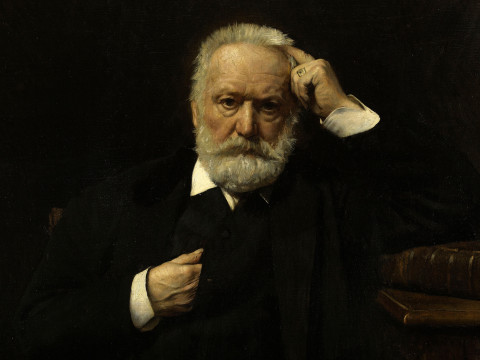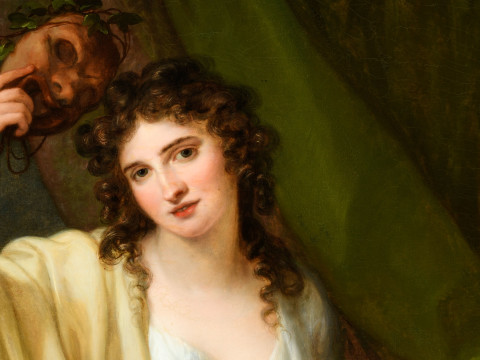
Nine eyebrow-raising moments from the Summer Exhibition
By Wes Gilpin
Published on 31 May 2022
From the time we rejected Banksy to Turner's "gunshot in the gallery", the Summer Exhibition has regularly ruffled the feathers of British art in its 254 years. Here are some of our favourite moments!
An earlier version of this article was published in 2020.

The gunshot in the gallery
Picture the scene. It’s Varnishing day at 1832’s Summer Exhibition – the final chance for the exhibiting artists to finish off their paintings before the show, and John Constable RA is applying the final touches to The Opening of Waterloo Bridge.
Enter Constable’s great rival Turner, sweeping into the room and observing that his own calm seascape, Helvoetsluys, is looking lacklustre. Turner marches up to his painting and with one flourish of his brush adds a red buoy in the middle of the canvas. This addition changes the dynamic of his composition completely.
Constable was devastated, saying it was like Turner had come in and “fired a gun!”. The altercation encapsulates their artistic rivalry perfect, and was recently immortalised in Mike Leigh's film Mr. Turner.

The comedian in the corner
In 2018 Comedian Joe Lycett submitted a bust called Chris, which he claims he had made out of clay and a Pringles can while drunk one night.
Upon receiving Lycett’s submission, the Summer Exhibition team emailed him about whether there was a mistake in the artwork’s cost, which he priced at £10,500,000. In reply he wrote: “Gosh, did I really put £10,500,500? It should be £12,500,000! Brexit! I recently took it to Bonhams to get it valued – they asked me to leave but I expect the insurance value is £4.99 or the equivalent in Argos vouchers.”
Joe’s work made it into the exhibition, and on Varnishing day he was able to see where it had been installed. However, much to his dismay, poor Chris had been placed on the floor in the corner – Joe's reaction was captured on BBC 1's The One Show.

The Hone ultimatum
Every year there are a few people who don’t agree with the works selected for the final hang. Not many, however, threaten to remove their own work because they object to another exhibited work, though this is exactly what founding Royal Academician, Angelica Kauffman, did in 1755.
At first glance,The Conjurer depicts an old man surrounded by a storm of artworks, a child at his knee – pretty harmless, right? But when you know the old man is allegedly Joshua Reynolds and the child represents Kauffman, then you can see how the painting was interpreted as a thinly veiled critique of a rumoured affair between the two.
Kauffman threatened to remove her work from the exhibition in a letter sent to the Royal Academy's President and Council, stating: “I have but one request to make, to send home my Pictures if that is to be exhibited”. The Committee appeased Kauffman’s wishes and removed the work, demonstrating her important status within the Academy. Disgruntled by his omission, Hone went on to display the work in a one man show in St Martin’s Lane.

The big debate
Over the years the RA has facilitated many rigorous debates, and in 2019 artist Jeremy Deller continued this tradition by hanging a large flag in the Galleries that declared “We are all immigrant scum”.
The statement takes its language from the charged and polarised debates surrounding the UK vote to leave the European Union in 2016. Deller wanted to use the Summer Exhibition to approach a different audience, stating “It's a phrase I've had in my mind for some time. I wanted middle England to see this work, and I thought this was the environment to reach people.”
Reach people it did — the artwork garnered a fair amount of attention, particularly on social media. Although it polarised our audience, many agreed the work acts as a catalyst for a conversation we need to have:
"I think this is horrible and divisive but I suppose art is all about shocking people into talking so I guess you’ve achieved that."
"I’m an art teacher - for me, work like this provides great opportunities for discussion in the classroom. It’s relevant. Whether people like it or not or are offended is part of that discussion."

The plagiarist
We’ve all been guilty of copy and pasting from time to time, and Ramsey Richard Reinagle RA did just that – but unlike a naughty pupil bulking up their year 10 english essay, he didn’t get away with it.
In 1848, Reinagle sent in a painting called Shipping a Breeze and Rainy Weather off Hurst Castle for that year’s exhibition, but it wasn’t really his own work. Reinagle had purchased the painting from a broker and it was actually the work of a young artist, named J. W. Yarnold. Before submitting it to the exhibition Reinagle made some slight alterations, but not enough to deceive the RA.
He was deemed guilty and promptly asked to resign his diploma as a Royal Academician. Two years later, he tried to clear his name through two letters published in the Literary Gazette, but they were unsuccessful. So, before you grab a couple paragraphs from Wikipedia, maybe just do your own work.

The extraordinary painting
The Summer Exhibition is made famous by it’s salon hang, with hundreds of works filling the walls of the main galleries. Every now and then, however, one work shines above them all – and in 1822 that was David Wilkie RA’s The Chelsea Pensioners Receiving the London Gazette Extraordinary of Thursday, June 22d, 1815, Announcing the Battle of Waterloo!!!.
The painting depicts the pensioners receiving an issue of the London Gazette Extraordinary from the cavalry, containing news of the Battle of Waterloo. In the centre a cavalryman reads aloud from the paper, with the surrounding crowds listening closely. The painting was so popular with the public that people had to wait 30 minutes before they could have their turn to see the artwork up close.
In fact, viewers often had to fight for the best position to view the work as it wasn’t hung at eye level. A writer for The General Weekly Register even suggested a system where three rows of people would kneel, stoop and stand to efficiently accommodate as many viewers as possible. The RA took another approach to stop the jostling crowds damaging the masterpiece, installing a rail around the painting – a first for the Academy.

The dots
Back in 1865, a star was born at the summer exhibition. No, it wasn’t a famous artist, but the red dots used to represent a sold work. Originally in the shape of a star, the red dots became mainstay at the Summer Exhibition and soon grew to be commonplace at art fairs, and they’re still in use today.
In 2013, Royal Academician Cornelia Parker incorporated them into her own work, Stolen Thunder (Red Spot) – somewhat controversially taking a photo of one of the most successful prints from the 2012 show (reportedly Tracey Emin’s), digitally removing the original work but keeping the red spots as part of the piece.
Parker exhibited the resulting work in the following year’s Summer Exhibition. It was a massive hit, and remade versions of the work have been included in each Summer Exhibition ever since.

The triumphant feminists
Now, the RA has a bit of a rocky past when it comes to gender equality. Despite two founding members being women artists, it would take 168 years for Dame Laura Knight to become the third woman to become a full member.
1913’s Summer Exhibition marked a change in the right direction, with one third of the exhibiting artists being women. Critic Frank Rutter, a progressive writer for his day, described the year as evidence of ‘triumphant feminism’.
Despite this, a group of suffragettes gathered in the exhibition to protest. One of the protesters attempted to make a speech but detectives removed them from the galleries before she could start. It’s thought they were protesting the lack of recognition for women artists at the time.

The famous reject
Amongst the almost 20,000 public entries in 2018 for the Summer Exhibition there was one sent in under the pseudonym “Bryan K Gasmaan”. Nothing seemingly out of the ordinary here, and in the end the work was not selected by the judges.
Later, when Grayson Perry RA began to select his invited artists to show at the Summer Exhibition, he approached Banksy with an offer to exhibit a work. In response to the invitation, Banksy revealed they had already submitted a work using a fake name... Bryan K Gasmaan – an anagram of 'Banksy anagram'. They chose to submit an alternative work to the rejected entry – Vote to Love, an altered Vote Leave placard from the 2016 Brexit campaign.
Over its 250-year history, the Summer Exhibition judging panel has rejected Masters such as Édouard Manet, John Constable and Wyndham Lewis. When heading the judging panel, Grayson said: “Everyone who submits work, you’re in the mix… it’s a democracy, you know, of a sort – a very arbitrary one: I’m in charge!"

Visit the Summer Exhibition
Summer at the RA is not just a time of year, it’s the world’s most joyful art experience.
Run without interruption since 1769, the Summer Exhibition showcases art in all forms, from prints, painting, film and photography, to architectural works and sculpture by invited artists, Royal Academicians and emerging talent.
Related articles

3 things you didn't know about Victor Hugo
14 March 2025

The great art quiz of 2024
18 December 2024

A love letter to the gallery gift shop
18 November 2024

Angelica Kauffman: Art History's Heroine
4 April 2024

Start here: Angelica Kauffman
24 January 2024
